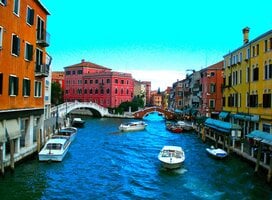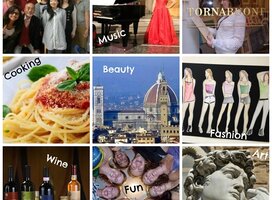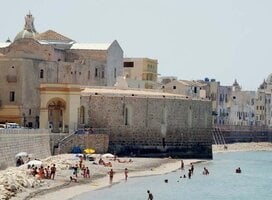Italian Language Schools in Milan, Italy
While thousands of language learners flock to infamous Italian cities such as Venice, Rome, Florence, or Perugia, each year, Milan isn't often on the top of Italian learners' lists.
But for those looking for a modern Italian city to learn Italian abroad, Milan should be. Milan won't offer you the sunny Mediterranean beaches of Sicily or the unrivaled history and art of Florence -- but it will offer you a stylish, modern European metropolis and a chance to learn Italian in Italy's industrial capital.
A quick train ride from Milan, you could find yourself in the foothills of the Alps, exploring crystal blue Alpine lakes or hiking to snow-capped peaks. On your weekends, explore Milan's unique mixture of Gothic and Renaissance architecture, high fashion, and delicious Northern Italian cuisine.
For Italian learners who want a little more edge or professional development in their language studies -- or to simply be close to a cool, mountainous region -- Milan may be just the location you're looking for.
Although Italian has far less variation than Portuguese, Spanish, and even French, it does have three main regional variations: southern, central, and northern Italian.
In Milan, people speak the Milanese variation which is similar to the Florentine (classical) dialect, thus reminds the classical Italian language that many people know from classical Italian literature, movies, and songs. Lets get in to your options for studying classic, Florentine Italian in Milan:
University Language Programs
Universities language programs usually offers Italian language classes for Italian learners who are planning on a longer stay or are studying Italian as part of a study abroad program. If you plan to stay only couple of months just to learn Italian you should consider studying at a private school.
Private Schools
Most language schools include lots of cultural events or courses for their students to not just learn Italian, but also Italian culture. This may include watching movies in Italian, attending exhibitions, concerts, dining out at traditional restaurants and pizzerias, going to bars for aperitivi (happy hour), or -- our totally biased favorite -- Italian cooking classes (yum!)
Regardless of which school you end up choosing, you'll likely be able to choose from one of the following options:
- Standard Italian language course in a group. Usually 20 hours per week.
- Private, one-on-one classes with a teacher.
- A combination of group classes and tutoring
- Industry specific language classes (for fashion, engineering, or business professionals)
- Italian language and cooking classes (less common, but there!)
Around Town
Modern, active, and bustling, you'll be able to find things to do in Milan -- no matter the time of day.
Piazza del Duomo is a central tourist attraction and home to the world-famous gothic cathedral, Il Duomo. Don’t forget to visit nearby gelaterias for a sample (or three) of Italian gelato, or linger awhile over an espresso at a cafe.
Also notable is Via Dante, a pedestrian boulevard lined with fashionable boutiques, outdoor cafes, restaurants, street performers, vendors, and amazing architecture. Come here to get a first hand taste of Milan's fashion scene, historic buildings, and Milanese culture.
For more shopping, head to glass-roofed Galleria Vittorio Emanuele ll, or if operas are more your thing, La Scala has hosted some of the world’s most famous opera and regular performances take place throughout the year.
Although you'll want to spend as much time as possible getting to know your host city, Milan is a great jumping off point for weekend longer getaways. On the weekends, head to the nearby mountains for skiing and snowboarding in the winter, or swimming in Il Lago di Como in the summertime. After your course, hop on a train for a couple of hours and explore more of Italy, France, or Switzerland.
Where to Live / Stay
When considering where to live / stay in Milan, Brera/Solferino is an expensive but centrally located area.
Magenta / Vincenzo Monto, also centrally located, is a charming area next to Parco Sempione.
University students may want to consider a place in the Citta Studi area. However, though this area is convenient for students studying at the university, it doesn't have the best transportation for getting elsewhere.
Naviglio has a charming, classically Italian feel to it, and has a great variety of nearby pubs and cafes. It's particularly lively if you're heading to Milan over the summer for your Italian course.
Culture
Although Northern Italians tend not to be as outgoing as Southern Italians, you'll still see a fair amount of Milanese talking with their hands, speaking loudly, or getting a little closer to you than you're used to at home. Italians are very friendly to tourists and usually talkative. Take advantage of it to practice your language skills!
Prices for learning Italian varies depending on the school or university. Naturally, prices tend to be a little pricier at a private school (though this may be your only option if you're out of college). Expect to see course rates start at 150 euros per week for basic Italian course in a group.
If you want to really have an immersion experience by living in a homestay, expect to spend around 500 euros per month (600 euros with breakfasts) on your homestay.
For those who are finding housing independently, a studio apartment will cost around 1,000 euros for a month, while a one bedroom will run around 1,200 euros. Some areas tend to be more expensive than others, so definitely look around.
A meal in an inexpensive restaurant costs around 15 euros and a one way ticket for metro or bus is about 1.50 euros.


















